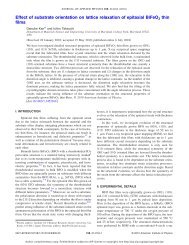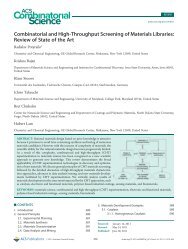Spring 2011 - Materials Science and Engineering - University of ...
Spring 2011 - Materials Science and Engineering - University of ...
Spring 2011 - Materials Science and Engineering - University of ...
You also want an ePaper? Increase the reach of your titles
YUMPU automatically turns print PDFs into web optimized ePapers that Google loves.
facultyNEWS<br />
Takeuchi Elected APS Fellow<br />
Pr<strong>of</strong>essor Ichiro Takeuchi was elected to<br />
Fellowship in the American Physical Society<br />
(APS). The Council <strong>of</strong> the APS cited<br />
Takeuchi “for pioneering contributions to<br />
the creation <strong>of</strong> novel classes <strong>of</strong> materials<br />
using combinatorial synthesis <strong>and</strong> probing<br />
their properties with novel probes.”<br />
Founded at Columbia <strong>University</strong> in<br />
1899, the APS has 46,000 members <strong>and</strong> is<br />
the publisher <strong>of</strong> Physical Review Letters, the<br />
top physics journal in the nation. APS Fellows<br />
constitute no more than one half <strong>of</strong> one<br />
percent <strong>of</strong> the total membership.<br />
Takeuchi is one <strong>of</strong> the relatively<br />
few scientists worldwide who specializes<br />
in combinatorial materials science (also<br />
known as “combi”), which allows for<br />
the rapid screening <strong>of</strong> a large number <strong>of</strong><br />
compositionally varying samples to determine<br />
if any have the characteristics the researchers<br />
desire, saving time <strong>and</strong> money in the process.<br />
Only a h<strong>and</strong>ful <strong>of</strong> facilities capable <strong>of</strong> this<br />
kind <strong>of</strong> work exist throughout the world,<br />
<strong>and</strong> the one Takeuchi manages, the Keck<br />
Laboratory for Combinatorial Nanosynthesis<br />
<strong>and</strong> Multiscale Characterization, is unique<br />
among American universities.<br />
One <strong>of</strong> Takeuchi’s highest-pr<strong>of</strong>ile combi<br />
projects was the discovery <strong>of</strong> a new, lead-free<br />
piezoelectric material whose properties are<br />
comparable to PZT, a lead-based compound<br />
currently widely used in electronics.<br />
His other research interests include the<br />
fabrication <strong>and</strong> characterization <strong>of</strong> novel multilayer<br />
thin-film devices, development <strong>of</strong> scanning<br />
probe microscopes, thin-film deposition<br />
<strong>and</strong> characterization, device fabrication, <strong>and</strong><br />
low temperature measurements.<br />
Takeuchi’s work has won him numerous<br />
grants <strong>and</strong> honors, including the ONR Young<br />
Investigator Program Award in 2000, the<br />
NSF-CAREER Award in 2001, <strong>and</strong> being<br />
selected to attend the National Academy<br />
<strong>of</strong> <strong>Engineering</strong>’s 2008 U.S. Frontiers <strong>of</strong><br />
<strong>Engineering</strong> Symposium. He was named a<br />
<strong>University</strong> Research Leader for his success in<br />
bringing millions <strong>of</strong> sponsored research dollars<br />
to campus, including its first Department <strong>of</strong><br />
Energy Advanced Research Projects Agency—<br />
Energy (ARPA-E) grant to develop a smart<br />
alloy that could make cooling systems up to<br />
175% more efficient, <strong>and</strong> a U.S. Defense<br />
Advanced Research Projects Agency (DARPA)<br />
grant that funds the exploration <strong>of</strong> new ways<br />
to construct highly-sensitive magnetometers.<br />
Takeuchi earned his Ph.D. in physics<br />
at the <strong>University</strong> <strong>of</strong> Maryl<strong>and</strong>, College Park<br />
in 1996. After working as a postdoctoral<br />
fellow at the Lawrence Berkeley National<br />
Laboratory, he returned to campus to join<br />
the MSE faculty in 1999. He has been a<br />
visiting pr<strong>of</strong>essor at institutes, laboratories<br />
<strong>and</strong> universities in Germany <strong>and</strong> Japan<br />
(see p. 5), <strong>and</strong> has been a guest researcher<br />
at the National Institute <strong>of</strong> St<strong>and</strong>ards <strong>and</strong><br />
Technology since 2002.<br />
Takeuchi is the fourth member <strong>of</strong> the<br />
MSE faculty, <strong>and</strong> the second in the past three<br />
years, to become an elected fellow <strong>of</strong> the<br />
APS, joining Pr<strong>of</strong>essor <strong>and</strong> Chair Robert M.<br />
Briber, Associate Pr<strong>of</strong>essor Luz Martínez-<br />
Mir<strong>and</strong>a, <strong>and</strong> Maryl<strong>and</strong> NanoCenter director<br />
Pr<strong>of</strong>essor Gary Rubl<strong>of</strong>f.<br />
3<br />
nsf-careerREASEARCH<br />
From Pr<strong>of</strong>essor Joonil Seog’s Molecular Mechanics <strong>and</strong> Self- From Pr<strong>of</strong>essor John Cumings <strong>and</strong> the Nanoscale Imaging,<br />
Assembly Laboratory: Stretching <strong>and</strong> relaxing a single biological Spectroscopy, <strong>and</strong> Properties Laboratory: Electron microscopy<br />
molecule using optical tweezers. The top bead is “tweezed” by shows the interaction <strong>of</strong> artificial magnetic atoms on an<br />
a laser light <strong>and</strong> the bottom bead is fixed onto a pipette tip. A experimentally-defined lattice: A) various configurations <strong>of</strong><br />
biological molecule (e.g. DNA) is tethered between the two beads the interacting vertices, showing magnetic monopoles at the<br />
<strong>and</strong> can be repeatedly pulled <strong>and</strong> relaxed, revealing the mechanical intersections. B) Under the influence <strong>of</strong> a magnetic field, monopoles<br />
properties <strong>of</strong> the biomacromolecules at the single molecule level. move through the lattice, producing reversal patterns that will be<br />
This method can also provide very useful information about studied in the course <strong>of</strong> Cumings’ research project.<br />
dynamic properties <strong>of</strong> biomolecules, which can shed light on protein<br />
folding, self-assembly, <strong>and</strong> protein-protein interactions. Illustration<br />
by postdoctoral research associate Chenyang Tie.<br />
A. James Clark School <strong>of</strong> <strong>Engineering</strong> Glenn L. Martin Institute <strong>of</strong> Technology












